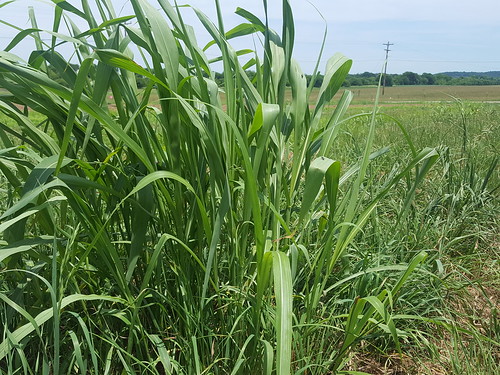Maintaining control of Johnsongrass
By Ryan McGeeney
U of A System Division of Agriculture
June 8, 2018
Fast Facts:
- Johnsongrass is a good forage in most ways, but needs to be contained
- Defoliation through mowing or grazing is a grower’s best bet
(454 words)
(Download this story in MS Word format here.)
LITTLE ROCK – Some blessings are just one stray seed away from being a curse, as anyone who’s tried to keep forages separated can tell you. And Johnsongrass, known to be an outstanding forage in and of itself, is the perfect example.
While Johnsongrass is a good quality forage, it can be challenging to control in pastures where the perennial, warm-season grass is not desired. Prussic acid production under stress can pose a risk to livestock when grazing Johnsongrass, especially during prolonged droughts or after a frost.
The challenge with Johnsongrass is to persistently control it with a long-term strategy, not just once or twice a year when it shows up in pastures, said Dirk Philipp, Associate Professor of Animal Science for the University of Arkansas System Division of Agriculture.
“Johnsongrass develops a vast system of thick rhizomes that gives it an edge over most other plants, especially in lower-laying and wetter areas of the farm,” Philipp said.
Rhizomes are underground storage organs from which shoots can regrow after clipping, Philipp said. These rhizomes can grow to extraordinarily length, even a few feet into the ground. Because of this, Johnsongrass is very persistent, and can withstand control measures if not done strategically at the right time.
Philipp said the one key to controlling Johnsongrass is timely defoliation through mowing or grazing.
“Mowing will work best in spring and fall,” he said. “During that time, carbohydrate concentrations in the rhizomes are low, and the plants are most vulnerable.”
Philipp advises forage managers to mow frequently — every time plants reach 12-15 inches in height, as a matter of fact. Carbohydrates reportedly replenish fully within 30 days after clipping, so mowing should be done more often than once a month. Moreover, mowing likely has to be done over several growing seasons to be fully effective, he said.
There are options available for controlling Johnsongrass through herbicides.
“Glyphosate works great but can only be done if no other forages or plants are of concern in the field,” Philipp said. “Other, more specific, herbicides are available, but those can be costly.”
When spraying, plants should be actively growing and relatively mature. In pastures with other grasses, Johnsongrass plants can be wiped with herbicides as its leaves are relatively tall above the pasture canopy, Philipp said.
The best possible Johnsongrass control, however, lies in proactive prevention, Philipp said.
“Never let Johnsongrass go into full bloom,” he said. “The seeds are viable and can be transported with wind over longer distances. Mow, clip, or graze while growth is young, and develop a long-term strategy for controlling Johnsongrass — that may include all possible forms of control.”
To learn about forage management in Arkansas, contact your local Cooperative Extension Service agent or visit www.uaex.uada.edu.
About the Division of Agriculture
The University of Arkansas System Division of Agriculture’s mission is to strengthen agriculture, communities, and families by connecting trusted research to the adoption of best practices. Through the Agricultural Experiment Station and the Cooperative Extension Service, the Division of Agriculture conducts research and extension work within the nation’s historic land grant education system.
The Division of Agriculture is one of 20 entities within the University of Arkansas System. It has offices in all 75 counties in Arkansas and faculty on five system campuses.
Pursuant to 7 CFR § 15.3, the University of Arkansas System Division of Agriculture offers all its Extension and Research programs and services (including employment) without regard to race, color, sex, national origin, religion, age, disability, marital or veteran status, genetic information, sexual preference, pregnancy or any other legally protected status, and is an equal opportunity institution.
# # #
Media Contact: Ryan McGeeney
of Communication Services
U of A System Division of Agriculture
Cooperative Extension Service
(501) 671-2120
rmcgeeney@uada.edu
